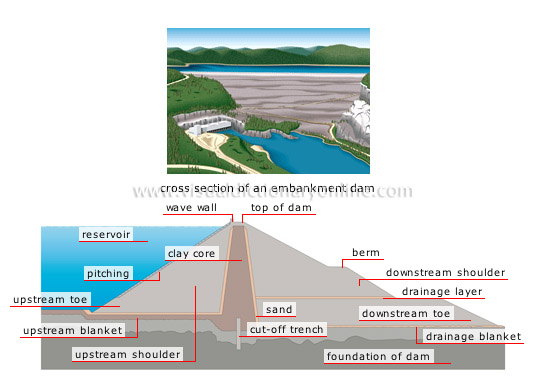DAMS
. A dam may be defined as a solid barrier constructed at
suitable location Across river valley with a view of impounding water flowing
through That River.
OR
. Dams are hydraulic structure built across rivers
and stream to confine water
On upstream side and
utilize this flow of water for multipurpose.
Dams are
created for the following objectives Or Purpose
- Generation of hydropower energy.
- Providing water for irrigation facilities.
- Fish farming.
- Fighting droughts.
- Controlling of floods.
- Water supply for domestic consumption.
- Providing navigational facilities.
DIFFRENT PARTS AND TERMINOLOGIES OF DAMS
Crest:
The top of the dam.
These may be in some cases be used for providing a roadway or walkway over the
dam.
Parapet
walls:
low
protective walls on either side of the roadway or walkway on the crest.
Spillway:
A spillway is a
section of a dam designed to pass water form the upstream side of a dam
to the downstream side.
Many spillways have
floodgates designed to control the flow through the spillway
Free Board:
This is the free board can be defined as the distance between the mix water level normal water
level of the dam this distance between the maximum and normal water level it is
called free board.
Gallery:
A gallery is the small tunnel like way for the different
purposes it may be provided and the longitudinal direction are in the transverse
direction provided for storage of the equipment used to determine the
performance of the building or the small spaces room provided for the people to
live . The dam specification inside this room . A passage tunnel provided
inside the dam .
Sluice way:
A provided to clear the silt accumulation in the reservoir .
Heel:
Portion of the dam in contact with ground or river-
bed at upstream side.
Toe:
portion of the dam in contact with ground or river-bed
downstream side.
Types of Dams
Classification of dams can be two types.
- Based on function .
- Based on structure and design .
BASED ON
FUNCTION:
.Storage dam.
It is a structure
The major purpose of
this structure is to store water.
.Diversion dam.
The major purpose f a diversion is to divert the water form
its natural
course.
Detention
dam.
In detention dam this also serves the purpose of a storage
dam but this detention dam prevents the floods at a entering into downstream
area this detention dam retains water in releases it gradually to the
downstream down this prevents a floods to flood prone areas.
Debris dam.
This dam prevents all the debris like silt and sand , locks
of wood leaves entering into the downstream side.
Coffer dam.
Coffer dam is
temporary structure which major purpose it restricts the water entering into
the construction site well construction process is going so this is temporary
structure.
BASED ON STRUCTYE
AND DESIGN:
Gravity
dam.
The gravity dam is the massive concrete or Rockville
structure with the weight of the dam itself restricts the horizontal thrust of
the water. The gravity dam have strong foundation
Arch dam.
In this arch dam we have it is curved in plan.it has a
convexity on the upstream side This diverts the horizontal thrust to the strong
abutments.
Buttress
dam.
This dam has a long concrete reinforced concrete slab which
is supported by these buttresses this structure totally restricts the
horizontal thrust of the water.
Embankment
dam.
The section of this dam looks like an embankment it looks
like an hill where you have an impervious core. Coming to its strength this
don`t have concrete and asphalt as its major ingredients.
SELECTION
OF DAM SITE.
- Suitable foundation must be available.
- For economy, the length of the dam should be as small as possible, and for a given height, it should store the maximum volume of water.
- The general bed level at dam site should preferably be higher than that of the river basin. This will reduce the height of the dam.
- A suitable site for spillway should be available in the near vicinity.
- Materials required for the construction of dam should be easily available, either locally or in the near vicinity.
- The value of land and property submerged by the proposed dam should be as low as possible.
- The dam site should be easily accessible, so that it can be economically connected to important towns and cities.
- Site for establishing labor colonies and a healthy environment should be available near the site.
















0 comments:
Post a Comment